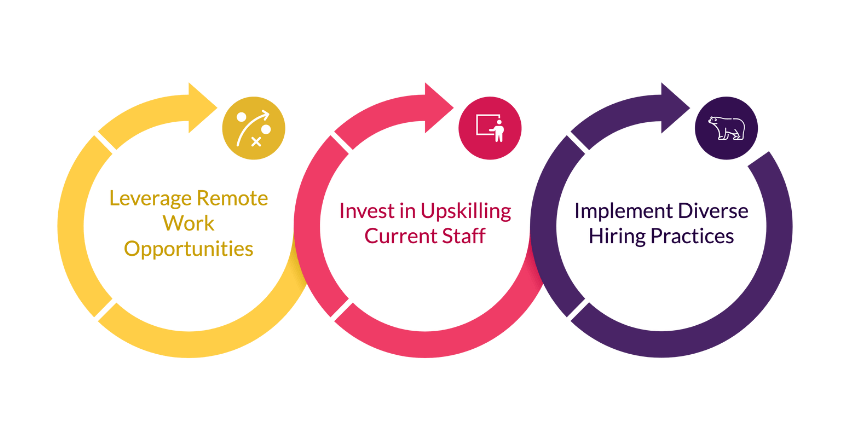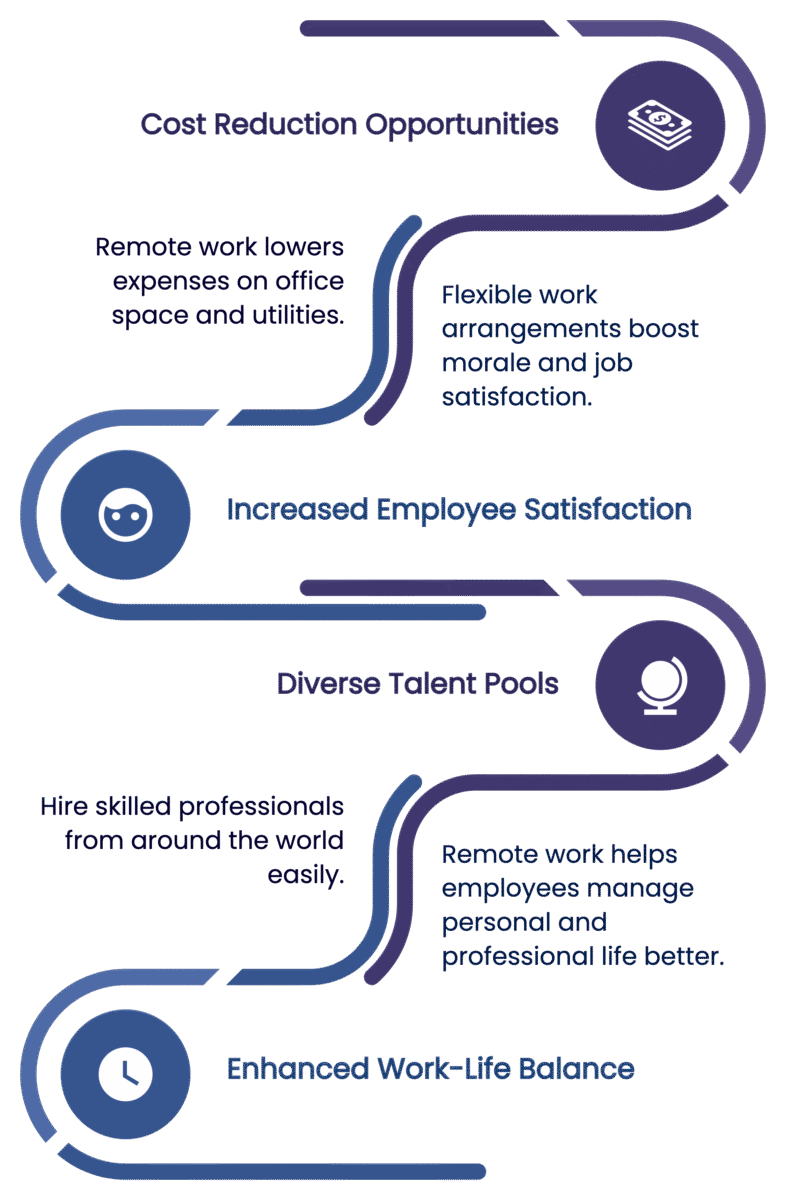
Modern workforce strategy to reduce tech hiring costs
The competition for tech talent is fierce, driving up salaries, recruiting fees, and onboarding costs. Many companies struggle to find cost-effective ways to meet tech needs without sacrificing productivity or quality. However, with innovative workforce strategies, organizations can significantly reduce tech hiring costs while still building highly capable teams.
Thank you for reading this post, don't forget to subscribe!Adopt Remote or Hybrid Work Models

Remote and hybrid work models have transformed how companies source and retain talent, providing opportunities to drastically reduce hiring and operational costs. By eliminating the traditional need for office-based employees, businesses can access a broader, more cost-effective labor pool while enhancing employee satisfaction and retention.
Access to Global Talent
One of the most impactful benefits of remote work is the ability to recruit talent from anywhere. This flexibility allows companies to tap into underutilized markets, including regions where labor costs are lower than in major tech hubs like Silicon Valley, New York, or London.
For example, instead of hiring a software engineer in San Francisco at an average salary of $150,000, a company could hire a similarly skilled developer from a lower-cost region such as Eastern Europe, India, or the American Midwest for a fraction of the cost. Expanding your search geographically not only reduces salary expenses but also gives you access to diverse talent with specialized expertise.
Moreover, this strategy helps mitigate hiring bottlenecks caused by high competition in saturated tech markets, reducing the need to offer excessive salary premiums to compete with local rivals.
Reduced Office Expenses
Remote and hybrid work options can lead to substantial savings on operational expenses. Maintaining a physical office incurs costs for rent, utilities, office supplies, and amenities such as coffee, cleaning services, and on-site perks.
Consider the case of tech giant Twitter (now X), which saved millions by scaling back office spaces and encouraging remote work. Smaller startups have also benefited by adopting fully remote models, allowing them to avoid costly leases and reinvest those savings into growth, technology, and hiring.
Even hybrid models, where employees work in the office part-time, allow businesses to reduce their office footprint and implement hot-desking, leading to more efficient space utilization.
Higher Retention Rates
Remote work improves employee satisfaction by offering greater work-life balance and autonomy, leading to reduced turnover. Studies have shown that employees who work remotely are often more productive and less likely to seek other job opportunities.
For instance, a survey by Owl Labs found that remote workers reported 22% higher job satisfaction and were 13% more likely to remain in their current roles compared to their in-office counterparts. High retention rates translate to reduced recruiting, onboarding, and training costssaving organizations both time and money.
Additionally, remote-friendly policies appeal to a broader range of candidates, including working parents, military spouses, and individuals with disabilities, all of whom may prefer or require flexibility in their work environments.
Example:
GitLab, a fully remote company, has been a pioneer in leveraging remote work to achieve cost-efficiency. By eliminating office-related expenses and hiring talent globally, the company has scaled its workforce while maintaining profitability. GitLab’s extensive remote culture also emphasizes employee well-being, contributing to a high retention rate and positive brand reputation in the tech industry.
Adopting remote or hybrid work models is a strategic move that offers businesses cost savings on salaries, office operations, and employee retention. By embracing flexibility, companies can attract top talent while staying agile in today’s evolving workforce landscape.
Tools to support remote work: Zoom, Asana, and Slack.
Leverage Freelancers and Contractors
Hiring full-time employees for every tech project isn’t always cost-effective. In many cases, freelancers and contractors provide a more flexible solution, especially for short-term or specialized projects.
Key Advantages
- Pay Per Project: Avoid the costs of benefits, insurance, and long-term salaries.
- On-Demand Expertise: Access specialists without having to invest in training.
- Faster Hiring Process: Freelancers can often begin working within days.
Platforms like Kaynes Upwork and Toptal can help you find qualified freelancers quickly.
Invest in Internal Training and Upskilling

Instead of searching for new hires to fill every gap, consider upskilling your existing employees. This strategy reduces turnover while fostering loyalty and expertise within your organization.
Ways to Implement Upskilling Programs
- Offer company-sponsored certifications (e.g., AWS, Google Cloud).
- Create mentorship programs between senior and junior employees.
- Use eLearning platforms such as Coursera or Pluralsight.
ROI of Upskilling
A study by LinkedIn revealed that companies prioritizing internal mobility see employee tenure improve by 2x. This leads to lower hiring costs in the long run.
Implement Employee Referral Programs
Your existing employees can be a powerful resource for identifying high-quality tech talent. Referral programs typically offer monetary incentives, which are often far less costly than traditional recruiting methods.
Why Referrals Work
- Better Cultural Fit: Referred candidates tend to integrate more easily.
- Reduced Hiring Time: Employees often recommend candidates who are job-ready.
- Higher Retention Rates: Referred hires are statistically more likely to stay longer.
Set up an incentive program where employees receive a bonus if their referral is hired and stays for a predetermined period.
Automate and Streamline the Hiring Process

Technology can drastically cut recruiting costs by automating repetitive tasks such as resume screening, interview scheduling, and candidate communication. AI-driven applicant tracking systems (ATS) allow HR teams to focus on high-value tasks.
Popular ATS Platforms
Automated hiring tools can reduce time-to-hire and minimize the risk of losing top candidates to competing offers.
Embrace Job Sharing and Part-Time Roles
Instead of overstaffing, companies can consider job-sharing arrangements where two employees share the responsibilities of one full-time role. This structure provides flexibility and allows organizations to tap into a broader range of candidates, such as parents re-entering the workforce or semi-retired professionals.
Adopt a Skills-Based Hiring Approach
Traditional hiring often emphasizes degrees and years of experience. However, companies can reduce hiring costs by focusing on specific skill sets instead. Skills-based hiring allows businesses to tap into non-traditional candidates, such as career changers and bootcamp graduates, who might demand lower salaries but bring high potential.
Skills Assessments Tools
- Codility for coding assessments.
- HackerRank for tech skill evaluations.
- TestGorilla for soft and technical skills testing.
This approach helps you avoid overpaying for credentials and instead prioritize candidates with demonstrable abilities.
Develop a Talent Pipeline Through Partnerships
Partnering with universities, coding bootcamps, and vocational programs can help you build a talent pipeline. Internships, apprenticeships, and co-op programs allow companies to train potential hires before making long-term commitments.
Examples of Partnership Programs
- Collaborate with local universities for tech internships.
- Partner with bootcamps like General Assembly or Flatiron School.
These partnerships can reduce recruiting costs by giving you access to pre-vetted, entry-level candidates.
Offer Competitive Non-Monetary Benefits
Candidates are increasingly interested in benefits that go beyond salary, such as remote work options, professional development, wellness programs, and generous PTO policies. Offering competitive non-monetary perks can make your company more attractive while allowing you to manage salary expenses.
Examples include:
- Unlimited PTO
- Flexible work hours
- Mental health support and wellness stipends
Research by Glassdoor found that 60% of job seekers consider benefits and perks a major factor in deciding whether to accept a job offer.
Utilize Data-Driven Workforce Planning
Using workforce analytics to predict staffing needs and identify cost-saving opportunities is a game-changer. Advanced analytics can help HR leaders optimize hiring timelines, avoid overstaffing, and plan for future needs.
Tools for Workforce Analytics
These insights can improve hiring accuracy, reducing wasted time and resources on unnecessary recruitment efforts.
Reducing tech hiring costs doesn’t mean sacrificing quality or scaling back your workforce. By embracing remote work, upskilling employees, leveraging freelancers, and automating recruitment processes, your company can attract top tech talent while maintaining a lean budget. The key is to stay flexible, invest in your current team, and take advantage of modern workforce solutions.


